"We are what we repeatedly do. Excellence, then, is not an act, but a habit." --Aristotle
Address any questions or comments regarding this newsletter to the individual authors listed after each article or to its editor, Rick Weinzierl, 217-333-6651, weinzier@illinois.edu. To receive e-mail notification of new postings of this newsletter, call or write the same number or address.
In This Issue:
Regional Updates (from Mike Roegge)
Notes from Chris Doll (harvest updates, comments on Retain and NAA, marestail)
Vegetable Production and Pest Management (UI cover crop research, late-season pumpkin insects)
Local Foods Issues (registering and maintaining a MarketMaker profile)
Upcoming Programs
- Illinois Pumpkin Day, September 6, 2012. 10:00 a.m. – 2:00 p.m., University of Illinois Vegetable Crops Farm, South First Street, Champaign, IL. For additional information, contact M. Babadoost by phone at 217-333-1523 or email at babadoos@illinois.edu.
- AGR-Lite Insurance Webinar, September 6, 2012. Addresses whole-farm insurance and other options for small, diversified farms. For more information, see https://attra.ncat.org/understandcropinsurance.
- Illinois Organic Growers Association 2012 Field Days. The Illinois Organic Growers Association has scheduled six field days in August and September. See the details at http://illinoisorganicgrowers.org/2012/07/03/2012-ioga-field-day-schedule/ .
- Income Opportunities for Small Acreages Workshop, September 4, 2012. 8:45 a.m. to 2:30 p.m. at the University of Illinois Extension Office, 980 North Postville Drive Lincoln, Illinois 62656. Topics will include: services and programs available for small farmers from NRCS & SWCD, farm records for USDA programs, organic certification, what’s new in organic farming research, and becoming an organic farmer. For more information, contact Amber Patrick at 309-833-4747.
- Growing Garlic for Market Webinar, September 5, 2012. This webinar will cover growing requirements, variety selection and management of garlic for market sales. For more information and to register, see http://web.extension.illinois.edu/registration/?RegistrationID=6981.
- Farm to Table, September 10, 2012. Tour the processing facilities at Goodness Greeness and tour Uncommonground Rooftop Farm, the first certified organic rooftop farm in the United States, both located in Chicago from 10:00 AM to 2:00 PM. For more information and to register, see http://farmtotablegoodnessgreenessuncommonground.eventbrite.com.
- Field and Wash Equipment for Small Vegetable Farmers; Organic Research Updates, September 11, 2012. Demonstration of field and wash equipment for small vegetable farms; tour the wash pack facility and learn about process of working toward GAP. View posters of current organic research from the University of Illinois at the University of IL Student Farm from 3:00-5:00 PM For more information and to register, see http://uofistudentfarm.eventbrite.com.
- Organic and Conventional Management Advances for High Tunnel Systems, September 21, 2012. Learn more about organic pest management, specifically steam sterilization of soil, and other management advances in high tunnel systems at the Dixon Springs Agricultural Center, 1:00-4:00 p.m. For more information and to register, seehttps://webs.extension.uiuc.edu/registration/?RegistrationID=6951.
- Living on the Land, October 1 through November 9, 2012. An 8-week series held on Mondays from 6:00 p.m. to 9:00 p.m. at the University of Illinois Extension Office, Will County, 100 Manhattan Road, Joliet, IL 60433. $150 per person for the series and $100 for an additional farm/family members. For more information, contact James Theuri at 815-933-8337 or jtheu50@illinois.edu.
- Illinois Specialty Crops, Agritourism, and Organics Conference, January 9-11, 2013. Crowne Plaza Hotel and Conference Center, Springfield, IL. More details to come, but mark your calendars. Workshops on January 9 will cover high-tunnel production systems, cover crops, basics of orchard establishment and management, and sweet corn production and pest management. Concurrent tracks on January 10-11 include fruits, vegetables, herbs, agritourism, organic production systems, and emerging issues and challenges in specialty crop production and marketing.
Regional Updates
In western Illinois, we finally received some much-needed precipitation over the past weekend. I received 1.4" at my home near Quincy. Others received from 0.3" to over 4". This was the most rainfall we've received in one day since April. It sure didn't raise the creeks or ponds, but was much welcomed. Prior to this rain event, I had recorded a total of 4.5" of rain since May 1.
The only annual crops that have survived to harvest are those that are receiving regular watering, and that's been getting tougher to continue. Every major stream/creek has quit running, except the spring-fed ones. Growers depending upon water from creeks were digging holding areas for water to accumulate, but they're disappearing rapidly. The same can be said for ponds, many of which are very low if not dry. Several producers are hauling water to supplement their vegetable crops, and are spending 20 plus hours each week doing so.
Water is essential for many of the small fruit crops this time of year, as they are now or will soon be setting fruit buds for next years' harvest. A lack of water at this time can be very detrimental, not only for survival but for nest years' crop. Strawberries, brambles, and other perennial fruit crops need one inch of rain per week (and more as temperatures increase).
Primocane blackberries and fall crop raspberries are blooming and producing fruit, but those not receiving supplemental water are providing negligible yields. Peach trees and apples are losing leaves as the trees are in a balancing act. A commercial apple grower noted that some limbs are entirely without leaves. Much of his Gala crop dropped to the ground, the Honey Crisp harvest was a quick one, as he's though.
Growers are setting fall cole crops and greens, and continue to pick the summer vegetables. Spider mites have affected a number of crops, including tomatoes and cucumbers. Cucumber beetle populations are high and seem to be more difficult to control this year. There has been an absence of powdery mildew on pumpkins, which seems odd as this disease prefers drier weather. Of course, the vines haven't grown enough to cover the field yet, so perhaps enough air is circulating to help prevent this disease.
Mike Roegge (217-223-8380; roeggem@illinois.edu)
Notes from Chris Doll
Travels on August 28 and earlier makes it look like it is September or even October. Soybeans are turning yellow, hundreds of acres of corn have been harvested, a big percentage of Jonathans have been picked, Goldens are being picked, but on the immature side, Delicious have decent sugar content, all Honeycrisp and some Jonagold have been cleaned from the tree, and Seckel pears are ripe. Rain showers in SW Illinois have been spotty, with some areas lucky with 2.5 inches and others unlucky with less than 0.5 inch. So drought conditions remain for most, and some of hurricane Isaac's water would be welcome if in moderation. It has only been four years since hurricane Ike came through three weeks later than this to break that year's drought, but lots of fruit was still on the trees, and losses from wind and water were significant.
A few apples were sampled for soluble solids yesterday with the following contents:
- 12-13 % Honeycrisp: juicy and sweet
- 13 % Jonathan: juicy and sweet and delicious
- 13 % Goldens: hardly edible
- 12 % Fuji: not edible but sizing well with irrigation
Very little red color is present on red varieties due to continued warm to hot temperatures, even at night. Sunburn is prevalent, with damage including brown to black burns, and lots of tan skin on red varieties. Some applications of Retain on Jons and Reds appear to have helped delay maturity and some dropping, and I'm sure we will hear more about that at the winter meetings. Losses from fruit drop in a year when the markets need all the apples it can get have been significant, especially on Jons. NAA worked if applied on time.
Harvest of apples, the remaining peach and pear varieties is now only 14-16 days ahead of last year. I'll watch the calendar to see when to expect Fuji harvest.
I've read about herbicide failures in other states where recent rains have helped weed seed germination. I mentioned this in relation to strawberry fields last week, and weeds are growing in this area where rains have occurred. A summer observation in this area is of a weed called marestail, one noted in soybean fields as resistant to the herbicide glyphosate. It has been common in orchards, unmowed lawns, and pastures where it is usually clipped in periodic mowing. It had the ability to bloom and set seed during the drought interval, so let's hope the plants that reproduced were not herbicide-resistant.
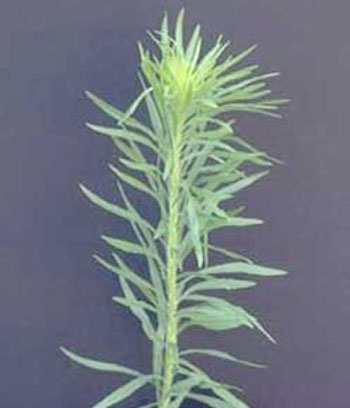
Marestail (Univ. of Arkansas)
Chris Doll
Vegetable Production and Pest Management
UI Cover Crop Research
We are currently conducting research on summer cover crops using practices simulating organic systems, but summer cover crops can be used by all vegetable growers.
What are summer cover crops and how can they can be used by vegetable growers? Summer cover crops include buckwheat, sorghum-sudangrass, and mustards that complete their life cycles in a short period of time. These cover crops are unique in that they do not take a whole growing season and can be used during fallow periods when vegetables are not being grown. All three cover crops are competitive, limiting weed emergence.
Each has its own planting window. For example, mustards can be planted early in the spring or late summer either before a warm season crop such as pumpkins or tomatoes is planted or after an early-season crop has been harvested. Mustards, when incorporated into the soil, release biologically active compounds that may inhibit some small-seeded weeds such as grasses, giving the crop a head start.
Buckwheat mellows the soil and can suppress some weeds through competition and the release of biologically active compounds. Buckwheat can be planted when nights are cool and days are warm, so buckwheat fits in a planting window in late spring or early fall when a summer vegetable crop such as lettuce or radish has completed its lifecycle or a crop of peppers or melons have been harvested. Buckwheat must be killed before seed are produced or it will become a weed itself.
Sorghum - sudangrass is the most competitive of the three cover crops. It requires warm temperatures thus must be planted by mid-May but can be killed when a summer or fall vegetable crop is planted. Another option when perennial weeds are a problem is to allow it to grow until frost kills the cover crop. Then a spring crop can be planted.
All cover crops require management skills, so as with any new practice, growers should start slow and see how they perform on your farm. We'll provide some results from U of I plots later this fall.
John Masiunas (masiunas@illinois.edu) and Dan Anderson
Late-Season Pumpkin Insect Management
Most pumpkin insect problems subside in September and early October prior to pumpkin harvest, but squash bugs, cucumber beetles and corn rootworm beetles, and aphids may persist and warrant control.
Squash bugs may continue to feed on vines and directly on pumpkin fruits. As vines die down, nymphs and adults feeding directly on fruits and “handles" can cause shriveling and distortion and produce wounds that allow entry of fruit rotting pathogens. Where fruit-feeding is occurring, squash bugs can be controlled with applications of Brigade, Warrior, or Mustang Max as listed in the Midwest Vegetable Production Guide.
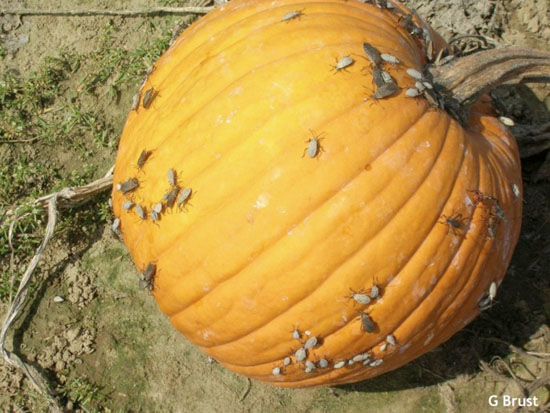
Squash bugs on pumpkin. (Photo by Gerald Brust)
Spotted cucumber beetles, striped cucumber beetles, and western corn rootworm beetles also feed directly on fruits, scarring the surface, making the frit unmarketable. Their feeding sites also provide entry for fruit-rotting pathogens. The pyrethroids listed above (Brigade, Warrior, and Mustang Max), products that contain the pyrethroid permethrin (Pounce and generics), and Sevin XLR Plus are among the most effective insecticides labeled for control of these beetles on pumpkins.
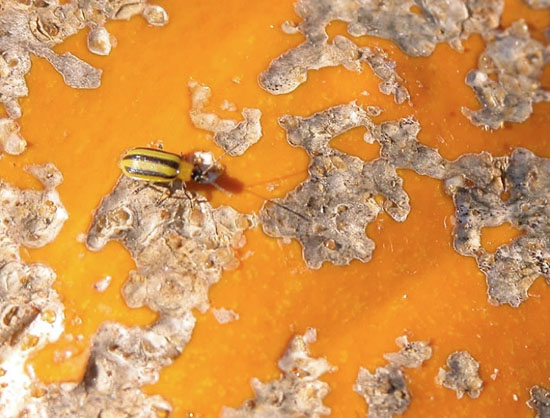
Striped cucumber beetle on pumpkin. (Photo by Ontario Ministry of Agriculture and Rural Affairs.)
As vines die down, aphid colonies move to pumpkin fruits, often around the handle and where the fruit rests on the soil. Their feeding may result in sunken areas on the fruit, and their presence, along with the honeydew they secrete, may reduce the crop's marketability. Aphid outbreaks often occur where a pyrethroid or Sevin XLR Plus has been used repeatedly through the season, killing lady beetles and other natural enemies that prey on aphids and limit their populations. Where aphid control is necessary at the end of the season, Assail, Fulfill, or M-Pede (or another insecticidal soap) can be used effectively. M-Pede is labeled for use in organic production; very thorough coverage is required for it to be effective. Actara is also an effective aphicide, but it is especially toxic to bees, so if any late flowering is still ongoing or if there are flowering weeds in the field, it should not be used.
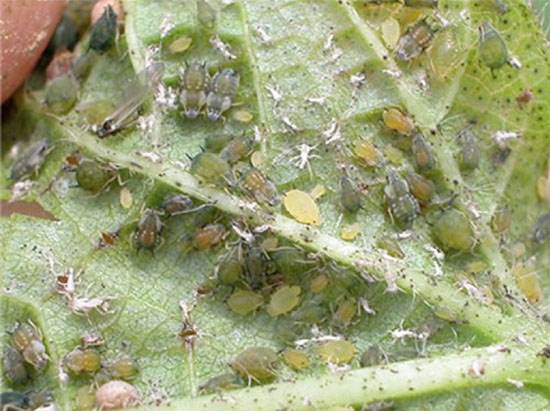
Cotton-melon aphid, Aphis gossypii (Univ. of Tennessee).
Rick Weinzierl (217-244-2126; weinzier@illinois.edu) and Megan Brant
Local Foods Issues
The Importance of Registering and Maintaining a MarketMaker Profile
MarketMaker is one of the most extensive collections of searchable food-related data in the country. It's an excellent way for you, as a producer, to let potential customers know exactly what you have to offer.
Creating a user account is simple. Go to Illinois MarketMaker: http://www.marketmaker.uiuc.edu/, and click on "Register Your Business." Follow the on-screen instructions to input your business information, being sure to select the correct product type tabs for your particular business. Remember to click “submit" after you've reviewed your information on the Business Preview page.
After you have submitted your information, you will automatically receive an email from MarketMaker that will include your username and temporary password. Your information will appear on the website within one or two business days.
By registering, you obtain the ability to change your password and update your information, subscribe to the Buy & Sell Forum and other alerts, and connect with other farmers and consumers by using Business Connections in your Member's Area.
There is NO COST to register!
MarketMaker is available to all users at no cost. Register your business, post an ad, and connect with other businesses -- all without any cost to you!
Once registered, it's important to keep your information up-to-date! Your customers need accurate business information. If a customer can't find you because your address, phone, or email has changed, they will move on to someone they CAN reach. Customers also need current product information so they know what you have to offer and how it's raised and/or sold.
MarketMaker offers simple registration and maintenance. If you need assistance, the MarketMaker Team is available to help. Email marketmaker@extension.uiuc.edu or call 309-757-9077.
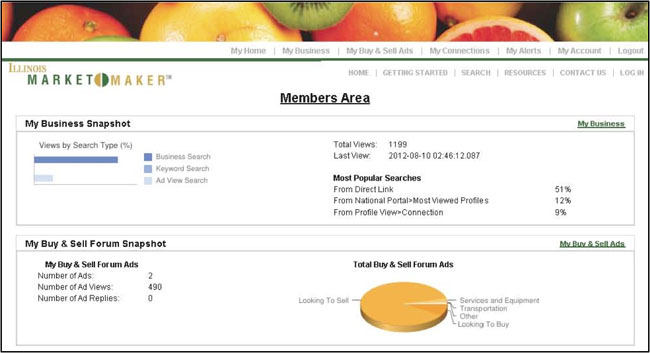
Lori Dalfonso (309-792-2577; dalfonso@illinois.edu)
Less Seriously ...
Again from NPR this week, from "All Things Considered" ... A few couples who married and decided to use hyphenated last names … and some who did not:
Mr. Rock married Ms. Singer to become the Rock-Singers.
Mr. Powers married Ms. Starr; now to be known as the Star-Powers.
When Miss Rush married Mr. Coffee, they appear to have decided against the hyphenated name Coffey-Rush.
So did Miss Lovely when she married Mr. Hooker.
University of Illinois Extension Specialists in Fruit and Vegetable Production & Pest Management
Extension Educators – Local Food Systems and Small Farms |
||
Bronwyn Aly, Gallatin, Hamilton, Hardin, Pope, Saline, and White counties |
618-382-2662 |
|
Katie Bell, Franklin, Jackson, Perry, Randolph, & Williamson counties |
618-687-1727 |
|
Sarah Farley, Lake & McHenry counties |
847-223-8627 |
|
Nick Frillman, Woodford, Livingston, & McLean counties |
309-663-8306 |
|
Laurie George, Bond, Clinton, Jefferson, Marion, & Washington counties |
618-548-1446 |
|
Zachary Grant, Cook County | 708-679-6889 | |
Doug Gucker, DeWitt, Macon, and Piatt counties |
217-877-6042 |
|
Erin Harper, Champaign, Ford, Iroquois, and Vermillion counties |
217-333-7672 |
|
Grace Margherio, Jackie Joyner-Kersee Center, St. Clair County |
217-244-3547 |
|
Grant McCarty, Jo Daviess, Stephenson, and Winnebago counties |
815-235-4125 |
|
Katie Parker, Adams, Brown, Hancock, Pike and Schuyler counties |
217-223-8380 |
|
Kathryn Pereira, Cook County |
773-233-2900 |
|
James Theuri, Grundy, Kankakee, and Will counties |
815-933-8337 |
|
Extension Educators – Horticulture |
||
Chris Enroth, Henderson, Knox, McDonough, and Warren counties |
309-837-3939 |
|
Richard Hentschel, DuPage, Kane, and Kendall counties |
630-584-6166 |
|
Andrew Holsinger, Christian, Jersey, Macoupin, & Montgomery counties |
217-532-3941 |
|
Extension Educators - Commercial Agriculture |
||
Elizabeth Wahle, Fruit & Vegetable Production |
618-344-4230 |
|
Nathan Johanning, Madison, Monroe & St. Clair counties |
618-939-3434 |
|
Campus-based Extension Specialists |
||
Kacie Athey, Entomology |
217-244-9916 |
|
Mohammad Babadoost, Plant Pathology |
217-333-1523 |
|